| November 4, 2024
The French manufacturer of battery-powered motorcycles, Electric Motion (EM), says its Escape XR is built with a clear purpose: “to provide endless riding opportunities and effortless handling for all skill levels and styles” and “caters to seasoned riders who seek top performance, yet remains a fantastic choice for newcomers aiming to develop their skills.” In other words, the Escape XR is a do-it-all off-roader for beginners and experts.
 Four-time Tecate Hare Scrambles winner Noah Kepple took on the Tennessee Knockout Hard Enduro on Electric Motion’s Escape XR Limited Edition e-motorcycle. Photo: Mason Simmons
Four-time Tecate Hare Scrambles winner Noah Kepple took on the Tennessee Knockout Hard Enduro on Electric Motion’s Escape XR Limited Edition e-motorcycle. Photo: Mason Simmons
We don’t doubt Electric Motion’s claim that the Escape XR is beginner-friendly; after all, what battery-powered motorcycle isn’t? But what about the company’s claim that the Escape XR caters to seasoned riders who seek top performance? That is a fair question, and we wanted an answer because we’re into performance, right?
So, what better way to test the EM’s performance than to compete in one of the toughest off-road races in the country—the Tennessee Knockout Hard Enduro—on the Electric Motion Escape XR? We contacted U.S. trials legend Geoff Aaron, who now works for EM, to make that happen. As he always does, Aaron pulled through, and I was the lucky one who got to race the company’s Limited Edition XR version in this year’s TKO race.
But first, a little EM background and description.
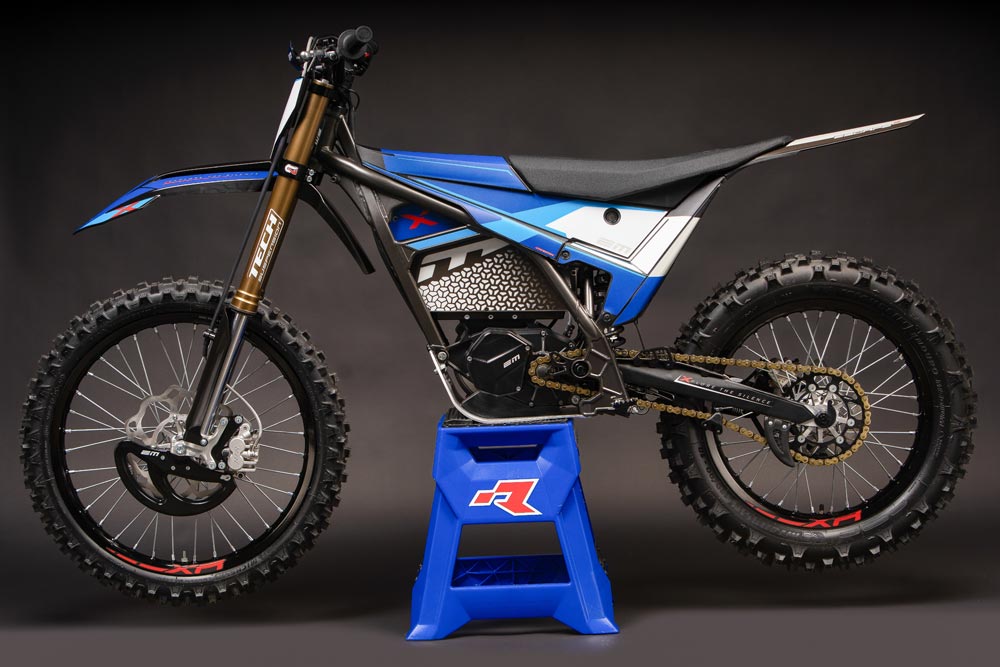 The Limited Edition (pictured) features a few racing-minded upgrades over the standard XR, most notably higher-end suspension components. Photo: Handsome Rabbit
The Limited Edition (pictured) features a few racing-minded upgrades over the standard XR, most notably higher-end suspension components. Photo: Handsome Rabbit
What’s the Escape XR?
Electric Motion emerged on the scene in 2010 and delivered its first e-motorcycle in 2012, the EMLite trials bike. Other EM trials models quickly followed. The company has since expanded into the off-road segment, offering a range of full-size electric off-road-style motorcycles, the latest called Escape. Electric Motion offers five Escape variants: Escape S, Escape R, Escape X, Escape XR and Escape XR Limited Edition. The S and R models are crosses between trials bikes and full-size off-road bikes, and the X and XRs are essentially full-on full-size off-roaders. The two XRs are more race-oriented than the X. The easiest way to tell them apart is the X has a headlight and the XR has a number plate. Look a little closer; you’ll see that the XR comes with handguards while the X does not.
Compared to the standard XR, the Limited Edition XR comes with upgraded Tech suspension (versus the XR’s Fast Ace fork and R16V shock), front and rear disc brake protectors, updated triple clamps and more torque (750Nm vs. 700Nm) from its latest 50.4-volt motor.
Compared to the X model, the XR is tuned for more torque and fitted with a higher-grade rear shock. A hydraulic diaphragm clutch is standard on the XR, optional on the X.
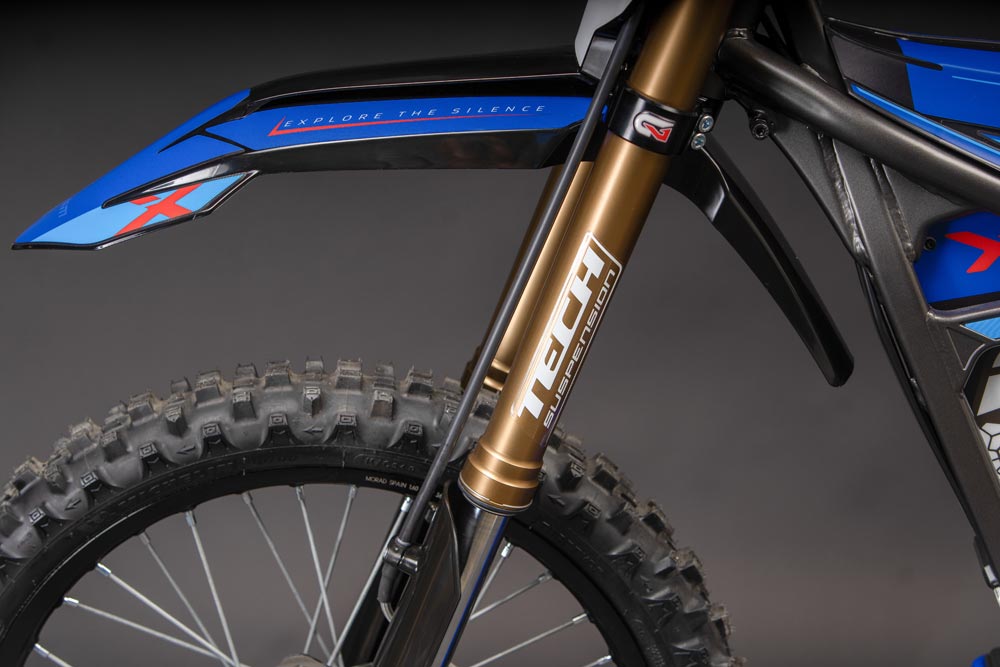 The Limited Edition XR is fitted with a 39mm Tech fork versus the standard’s 34mm Fast Ace fork. Photo: Handsome Rabbit
The Limited Edition XR is fitted with a 39mm Tech fork versus the standard’s 34mm Fast Ace fork. Photo: Handsome Rabbit
Electric Motion claims it is the first manufacturer to offer the public a fully functioning hydraulic diaphragm clutch for an e-motorcycle. This means the rider can modulate the motor’s power, load the suspension for big obstacles, and better control the rear wheel traction, “making it possible to conquer obstacles and clean sections that were never possible on an electric trials bike before.”
The LE model also comes standard with a PRB R lever (optional for the base model XR). The PRB R (Progressive Regenerative Braking) lever mounts to the clutch master cylinder just above the clutch lever. When engaged, it offers “engine braking,” and slows down the rear wheel while regenerating the battery.
This can help in technical riding situations and it won’t interfere with the clutch lever action, as the rider can use one or the other independently, or both at the same time.
Both XRs also come equipped with S3 footpegs, skid plates and Neken handlebars.
You pay more for the XR, $11,999, and XR LE, $12,999, versus the X’s $9999 price tag.
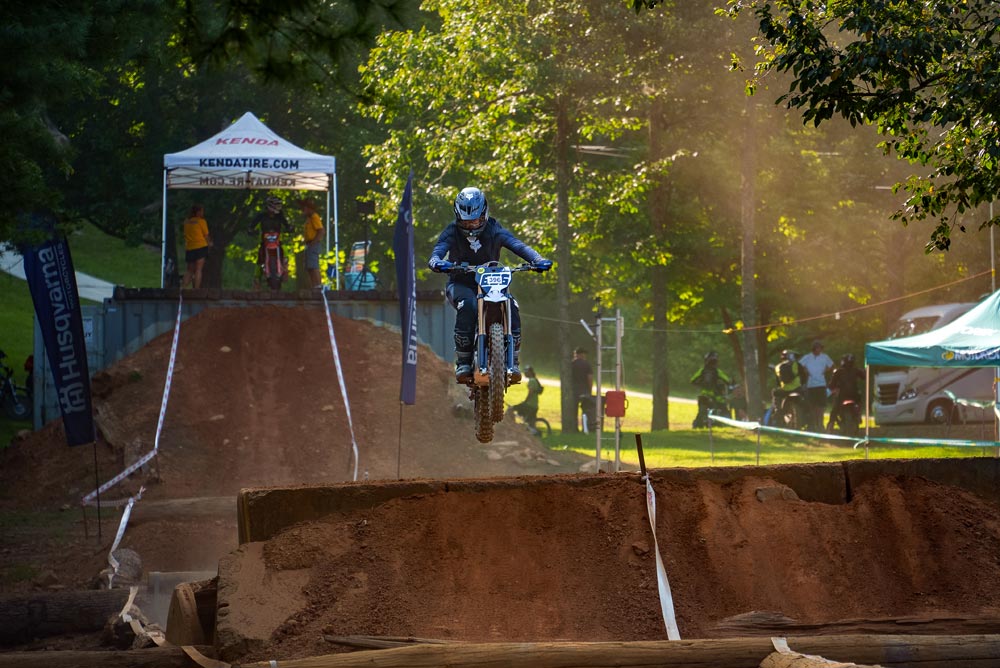 You can still feel Electric Motion’s trials DNA in the XR models. Photo: Jenny Keller Photography
You can still feel Electric Motion’s trials DNA in the XR models. Photo: Jenny Keller Photography
Pre-Race
Prepping the Electric Motion for the race was as simple as just plugging it in. Okay, maybe not that simple—I had to adjust the handlebars, levers and suspension clickers to my liking. Now, it was just riding it and getting used to it. At home in California, I practiced for the TKO race on the standard XR and raced the Limited Edition XR. Only 50 LE units will be available in the U.S. market.
Before the race, I was dealing with finish line anxiety, concerned about the EM’s 50.4-volt lithium-ion battery running out of juice during the race. It was rumored that the course was longer than normal this year, which would test the XR’s and competing electric manufacturers’ battery life. All I could do was worry about that later, like late in the race.
Riding the XR before the race, my first impression was how light and nimble it felt at slower speeds. Having a clutch certainly helped the bike feel more like a “normal” internal combustion engine. However, the power delivery did take some getting used to for a couple of reasons, one of which is sound. There is none. You don’t realize how much you rely on the sound of the engine in trail-like scenarios until you ride a silent motorcycle. Although the clutch is nice for modulating large amounts of power, for me, at first, the bike felt smoothest and easiest to ride when I didn’t rely on the clutch.
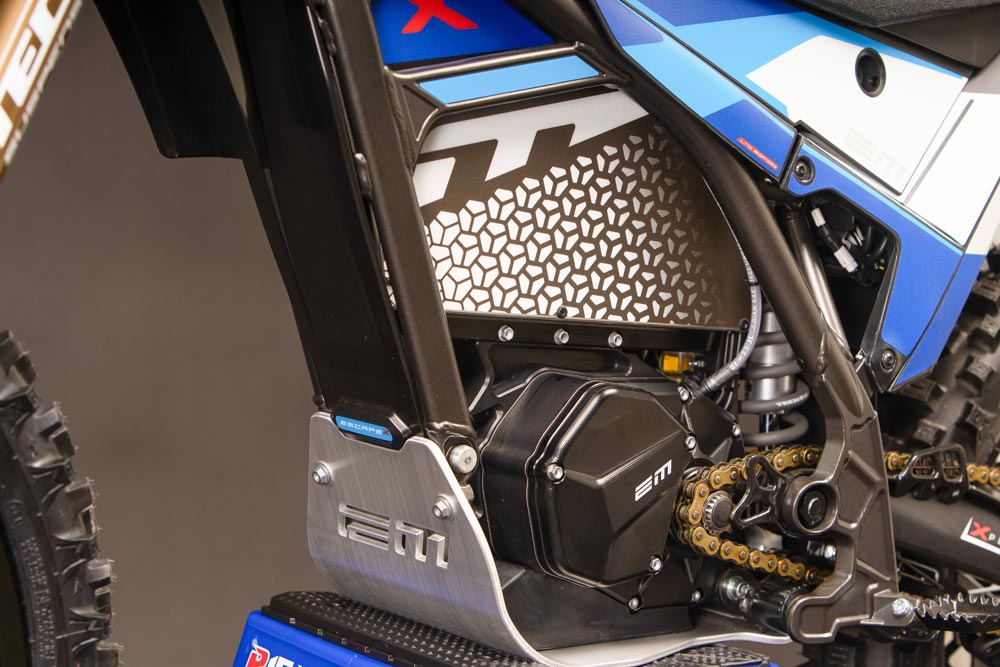 The XR already has gobs of torque, but the Limited Edition has slightly more. Photo: Handsome Rabbit
The XR already has gobs of torque, but the Limited Edition has slightly more. Photo: Handsome Rabbit
The EM’s footpegs are positioned further back than most traditional off-road bikes, which improves your sense of traction in loose conditions. You can clearly feel the EM’s trials heritage in the Escape’s DNA. The overall geometry tilts more toward trials than enduro.
The Electric Motion has a digital screen positioned at the top of the bar pad, similar to other electric brands. The TFT screen displays battery life, rpm, and your selected riding mode, which can be chosen via a switch on the handlebar. There are three options: easy, medium and hard.
The EM Connect tuning app makes it simple to fine-tune things even more, like throttle sensitivity, regenerative braking, power and TKO (Tick Over, which enables idle mode). I can confirm that each riding mode affects battery life. After six full rides on the bike, I noticed how each map varied in mileage and duration. On average, I could ride the bike at an aggressive training level for about 11-14 miles or 60-90 minutes. The battery performed very well in high heat, which was approximately 90 degrees in all my riding sessions.
The XR’s suspension was initially very plush, a little too plush. Things improved after I stiffened up the clicker adjustments to get the balance I was happy with.
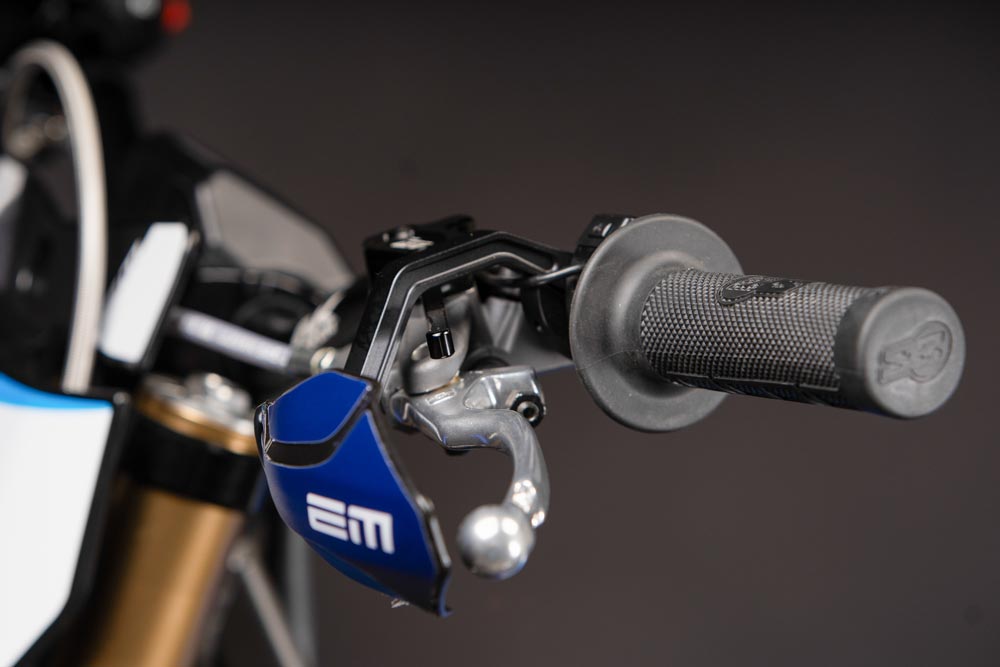 The small second top lever is the PRB R lever. Pulling this lever provides the effect of engine braking while also regenerating the battery. Photo: Handsome Rabbit
The small second top lever is the PRB R lever. Pulling this lever provides the effect of engine braking while also regenerating the battery. Photo: Handsome Rabbit
Green Flag
With preparation completed, we headed to the Tennessee Knockout. After all the usual minor adjustments (again, not much), the XR LE and I were ready to go, and we got off to a great start. We took a narrow margin of victory in the six-minute hot lap for the ECR eMoto class. This put me on the front row of Saturday’s qualifying race, where I placed second. Up next was the 14-mile main event, which would certainly test both me and the XR LE.
After our pre-race testing, my team knew it would be cutting it close to finishing the race on one charge. With other crews choosing to swap batteries mid-race, we stuck with the single-battery strategy and crossed our fingers.
The Escape XR LE proved to be bulletproof during the main event and endured the tough conditions that rival any other premier extreme enduro race. I crossed the line in fourth place with just enough juice left. Our strategy paid off. I ran the bike in the most conservative mode, map one, with just under 10 percent battery left after one hour and 16 minutes of hard-fought racing. Although the total duration does not reflect how demanding the course was, I would suspect the average racer would have no problem riding the same course and finishing with more battery than I did.
I loved how light and playful the bike felt underneath me. It preferred to ride on top of the rocks rather than smashing through them, which proved crucial in the tough conditions of the Trials Training Center grounds, where changing directions or getting stuck is common. Its nimble character made it easy to point and shoot while maintaining momentum through tighter sections of trail.
 Kepple prepared for the Tennessee Knockout at home in California on the standard XR model. The XR is a very capable off-roader that regularly lasted an hour to an hour-and-a-half of aggressive riding. Photo: Ryan Nitzen
Kepple prepared for the Tennessee Knockout at home in California on the standard XR model. The XR is a very capable off-roader that regularly lasted an hour to an hour-and-a-half of aggressive riding. Photo: Ryan Nitzen
The toughest thing I had to adjust to was the rider position. It has a unique rider triangle, especially when seated. With the pegs further back and the seat-to-peg ratio shorter than normal, it is, again, easy to feel the XR’s trials DNA.
The clutch was interesting. Without a traditional ICE powerplant spinning underneath you, the Electric Montion’s clutch feels either on or off. There isn’t a ton of modulation or feel like you have from a traditional ICE clutch. However, after getting used to it in the pre-race qualifying process, it did prove advantageous throughout the main event. You quickly learn to adjust to it. Add in the lack of noise, no gears, and only a few hours of ride time before the race; it was a completely different racing experience than what I’m used to on combustion bikes.

Loading Up
Although the Electric Motion may look like the ideal backyard play bike, I find it best suited for purpose-driven riders who want to develop skills close to home without making noise. The overall cockpit on this bike feels foreign at first, but most of that is due to my countless hours on more-traditional motocross and enduro models. The ideal buyer for the Electric Motion Escape XR is the family where dad wants a bike to play around on, mom can ride it around camp at the races, and the kids can grow into this bike while developing skills they’d normally not get to practice around the house. Anyone can get on this bike and twist it and go and have fun. Like EM said, the XR, LE included, will indeed meet the demands of the novice and the expert off-road rider.
With the ever-changing world of electric motorcycles, there is certainly a market for these silent assassins. Being able to talk to other competitors while racing the electric class was an experience unlike any other.CN
2024 Electric Motion Escape XR / Escape XR LE Specifications
| MSRP |
$11,999 / $12,999 |
| Motor Type |
Electric, Li-ion battery |
| Voltage |
50.4V |
| Capacity |
3500Wh |
| Charger |
25A |
| Peak Power |
12kW |
| Torque |
700Nm / 750Nm |
| Top Speed |
52.8 mph |
| Charging Time |
2:30 |
| Life Cycle |
1000 |
| Frame |
15CDV6 Steel |
| Swingarm |
Aluminum |
| Front Suspension |
Fast Ace 34mm fork / Tech 36mm Inverted fork |
| Rear Suspension |
R16V single shock w/ remote reservoir / Tech w/ reservoir |
| Front-Wheel Travel |
9.8 in. |
| Front Wheel |
1.6×21 in. |
| Rear Wheel |
1.85×18 in. |
| Front Tire |
Michelin Enduro Medium |
| Rear Tire |
Michelin Enduro Medium |
| Front Brake |
Single 260mm, Nissin |
| Rear Brake |
Single 220mm, Nissin |
| Wheelbase |
52.4 in. |
| Seat Height |
33.5 in. |
| Ground Clearance |
13.8 in. |
| Weight (wet, claimed) |
194 lbs. |
| Range |
49 mi. / 54.7 mi. |
| Top Speed |
52.8 mph |
